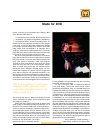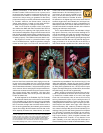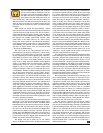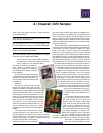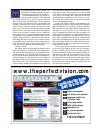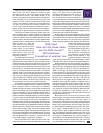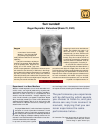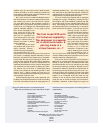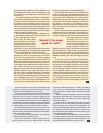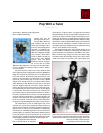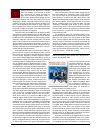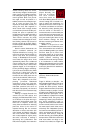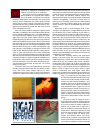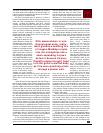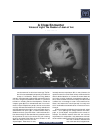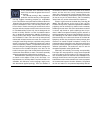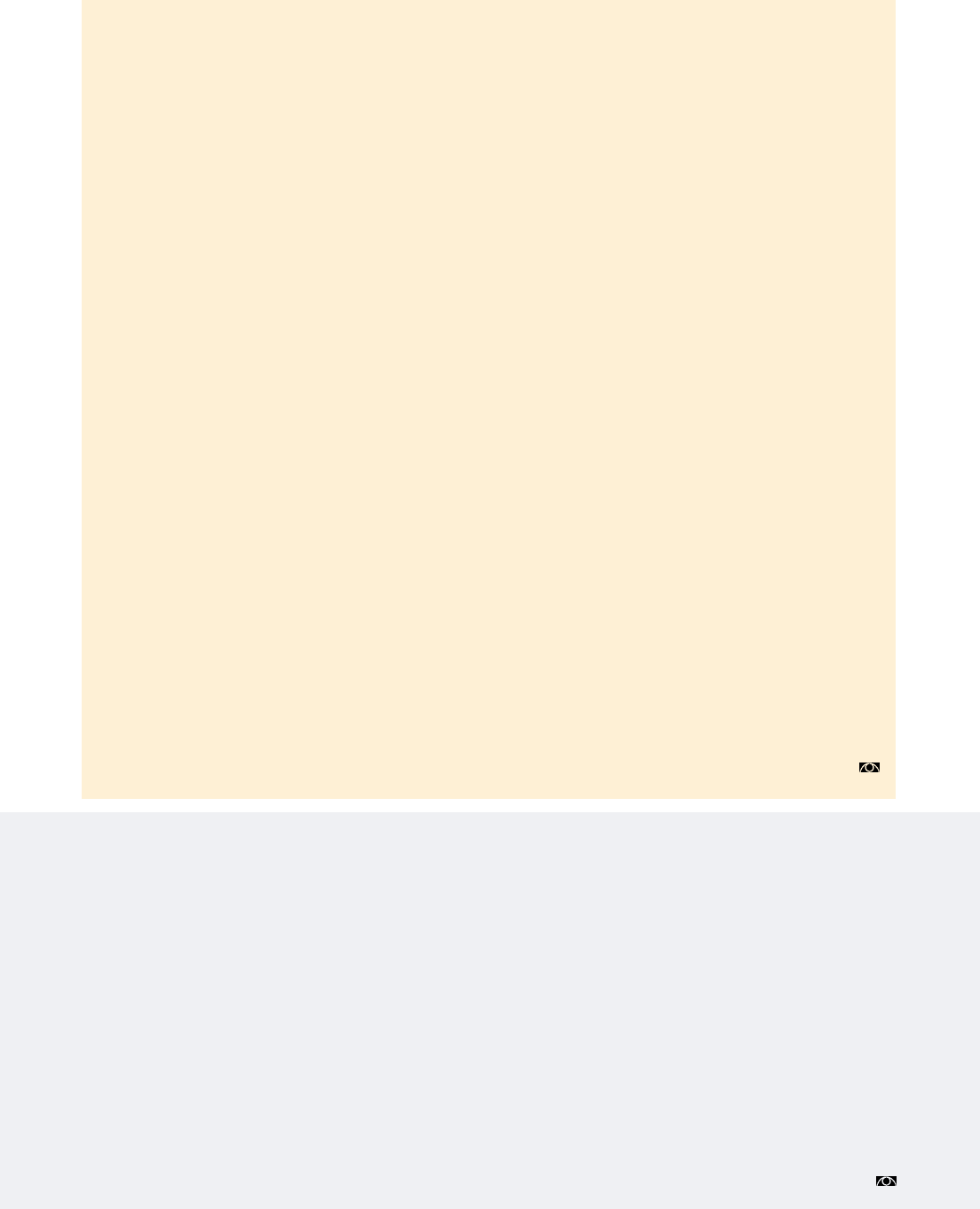
wandering, questing wiggles to a pulsing, stylized sun, all
choreographed to the music, but far more gripping. (Imag-
ine a dance with choreography more interesting than the
musical score.)
The largest, longest work we’re given is a 1996 compo-
sition with the name Watershed IV, and it’s a tour de force
for Schick’s percussion. He stands in the middle of a circle
of percussion gear, some familiar, some not, and at first I
hoped the surround sound would simply let us hear what he
hears, which would have been especially appropriate since
the conversation about the lengthy piece stressed its struc-
tural use of percussion sounds, drum sounds in one place,
maybe, succeeded by metallic effects.
What we get, however, is Peter Otto’s “spatialization,” or
in other words his processing of the sound to shift it around
in space, and sometimes in time as
well, to make the spatial effects
more noticeable. To put it different-
l y, he’s now applying his own kind of
c h o r e o g r a p h y, in this case a useful
m e t a p h o r, because he makes the
sounds move around in what might be some faint reminis-
cence of what dancers do. The only problem is that the piece
itself is unremarkable and in fact close to stultifying.
One obvious difficulty is its lack of any real rhythm,
astonishing in a work for percussion alone, and even more
so in a work this long. Why there’s no rhythm is suggested
by an excerpt from Reynolds’ written score, reprinted in the
DVD’s long, detailed (too detailed?) booklet. In what we’re
shown there, the percussionist is asked to play freely with-
in given spans of time, sometimes faster, sometimes slower,
but in rhythms he himself creates. In practice, these, to
judge from what we hear, tend to be remarkably uneventful,
essentially patterns of even notes. That creates a lulling
effect, not conducive to sustained listening. I could also say
that, while Otto is allegedly creating syntax by moving
sound in space, the most elementary kinds of rhythmic syn-
tax are completely missing. Odd. I couldn’t stay with Water -
shed at all. (Those with computer DVD-ROM drives can
check my theory; one added feature of this DVD is that they
can print out large sections of the Watershed score.)
The other items aren’t as striking, and to judge from the
blurbs on the back of the DVD package, which don’t men-
tion them, are essentially there to fill out the disc. First we
get an excerpt from The Red Act Arias, commissioned by
the BBC and premiered in 1997. The piece was originally for
live performers and 8-channel tape; we get just a little of the
tape segment, mixed down to five channels. I liked it,
maybe because it was short enough to be enjoyable just as
sound, without wearing out its welcome or making unjusti-
fied artistic claims.
And then came the best item on the DVD, a surprise not
mentioned on the box, in the booklet, or in the spoken com-
mentary. This is called An Odd Dream, and is a two-minute
excerpt from Watershed, with the visuals slowed down and
the sound processed to sound vague
and distant. The track is set to
repeat infinitely, and creates a uni-
verse of its own. I kept waiting for it
to end; I imagined changes that
weren’t really there, like the sound
getting more and more vague. That’s how the piece played
with my expectations. I myself became a participant, and I
think any listener would. Here, for once, we had something
that lived up to the high artistic claims made for Eclipse and
Watershed, something that really did change my percep-
tions.
This, in a word, was art. The rest of the DVD is acade-
mic timidity, though I’ll grant that the spatial journeys of
the sounds were interesting, and that 5.1 surround has
sonic potential that, outside of the obvious movie effects,
has only begun to be tapped. Reynolds, in the end, did me
one favor. He made me want to hear more music that uses
the full 360-degree rotation of real life – as long as we
understand that the spatial placement is just another kind
of color, another kind of narrative effect, similar to orches-
tration (playing music first on a violin, then on a clarinet),
or to the imaginative stereo mixes we already get on some
pop recordings. It’s not a new development in musical lan-
guage.
Shouldn’t the music
speak for itself?
I have transcribed this; it will give you a better idea of the
experience of listening to this piece. Both poems exist inde-
p e n d e n t l y, but taken together they convey a third.
Of course, the performance you experience will be defined
by which sounds you choose to listen to, and of course your
choice can vary from moment to moment, implying that you
subjectively can never experience the same performance twice
– a point that Roger Reynolds later pursues more blatantly in
“An Odd Dream,” which by repeating the same two-minute per-
formance creates a mantra that becomes a meditation and then
the ever-changing concentric reflections within a mandala.
M r. Reynolds is playing games, as he tells us in the accom-
panying interviews, and these are games played with our per-
ceptions of reality as distorted by time and space and the other
tricks in his sorceror’s cabinet.
As his percussionist Steven Schick tells us, at some point,
this stops being music and becomes ritual.
But we know the effect of endless repetition from cen-
turies of experience of ritual, so while the point is valid and
proven by this hidden bonus track, it is hardly novel. What is
novel is the use of new technology to “spatialize” the image,
and here Reynolds is in danger of becoming intoxicated by the
t e c h n o l o g y.
I think the composer has realized that one of the principal
advantages of this format lies in the improved control of the
room acoustic and he has used this to create a compellingly
robust sonic hologram.
This gives rise to a heightened realism that can be both
graphic and unnatural, and is carefully crafted by Reynolds. I
found the subtler, more “realistic” sounds beguiled my ear
more than those deliberately distorted by “spatialization,” and
by manipulations of the dynamic envelope. I should like to
hear this solidity of image achieved with no engineering, other
than the highest quality recording.
H o w e v e r, I think this a worthy experiment in a new medium
with some worthwhile results. And I did particularly savor the
utter tangibility of the imaging, even if each voice pops out of the
background like the illuminated red nose of a clown…



